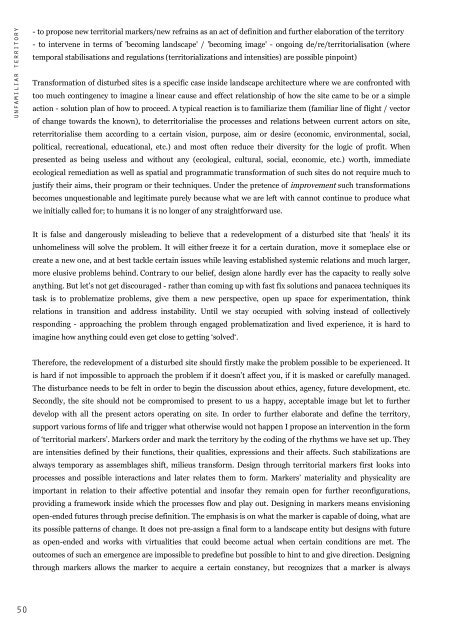Unfamiliar Territory_Research
You also want an ePaper? Increase the reach of your titles
YUMPU automatically turns print PDFs into web optimized ePapers that Google loves.
unfamiliar territory<br />
- to propose new territorial markers/new refrains as an act of definition and further elaboration of the territory<br />
- to intervene in terms of 'becoming landscape' / 'becoming image' - ongoing de/re/territorialisation (where<br />
temporal stabilisations and regulations (territorializations and intensities) are possible pinpoint)<br />
Transformation of disturbed sites is a specific case inside landscape architecture where we are confronted with<br />
too much contingency to imagine a linear cause and effect relationship of how the site came to be or a simple<br />
action - solution plan of how to proceed. A typical reaction is to familiarize them (familiar line of flight / vector<br />
of change towards the known), to deterritorialise the processes and relations between current actors on site,<br />
reterritorialise them according to a certain vision, purpose, aim or desire (economic, environmental, social,<br />
political, recreational, educational, etc.) and most often reduce their diversity for the logic of profit. When<br />
presented as being useless and without any (ecological, cultural, social, economic, etc.) worth, immediate<br />
ecological remediation as well as spatial and programmatic transformation of such sites do not require much to<br />
justify their aims, their program or their techniques. Under the pretence of improvement such transformations<br />
becomes unquestionable and legitimate purely because what we are left with cannot continue to produce what<br />
we initially called for; to humans it is no longer of any straightforward use.<br />
It is false and dangerously misleading to believe that a redevelopment of a disturbed site that ‘heals’ it its<br />
unhomeliness will solve the problem. It will either freeze it for a certain duration, move it someplace else or<br />
create a new one, and at best tackle certain issues while leaving established systemic relations and much larger,<br />
more elusive problems behind. Contrary to our belief, design alone hardly ever has the capacity to really solve<br />
anything. But let’s not get discouraged - rather than coming up with fast fix solutions and panacea techniques its<br />
task is to problematize problems, give them a new perspective, open up space for experimentation, think<br />
relations in transition and address instability. Until we stay occupied with solving instead of collectively<br />
responding - approaching the problem through engaged problematization and lived experience, it is hard to<br />
imagine how anything could even get close to getting ‘solved‘.<br />
Therefore, the redevelopment of a disturbed site should firstly make the problem possible to be experienced. It<br />
is hard if not impossible to approach the problem if it doesn’t affect you, if it is masked or carefully managed.<br />
The disturbance needs to be felt in order to begin the discussion about ethics, agency, future development, etc.<br />
Secondly, the site should not be compromised to present to us a happy, acceptable image but let to further<br />
develop with all the present actors operating on site. In order to further elaborate and define the territory,<br />
support various forms of life and trigger what otherwise would not happen I propose an intervention in the form<br />
of ‘territorial markers’. Markers order and mark the territory by the coding of the rhythms we have set up. They<br />
are intensities defined by their functions, their qualities, expressions and their affects. Such stabilizations are<br />
always temporary as assemblages shift, milieus transform. Design through territorial markers first looks into<br />
processes and possible interactions and later relates them to form. Markers’ materiality and physicality are<br />
important in relation to their affective potential and insofar they remain open for further reconfigurations,<br />
providing a framework inside which the processes flow and play out. Designing in markers means envisioning<br />
open-ended futures through precise definition. The emphasis is on what the marker is capable of doing, what are<br />
its possible patterns of change. It does not pre-assign a final form to a landscape entity but designs with future<br />
as open-ended and works with virtualities that could become actual when certain conditions are met. The<br />
outcomes of such an emergence are impossible to predefine but possible to hint to and give direction. Designing<br />
through markers allows the marker to acquire a certain constancy, but recognizes that a marker is always<br />
50


